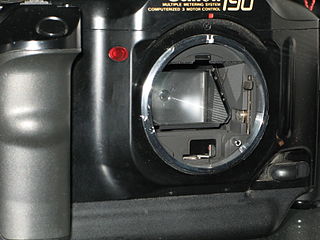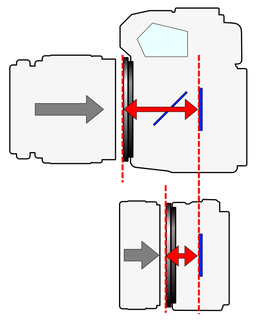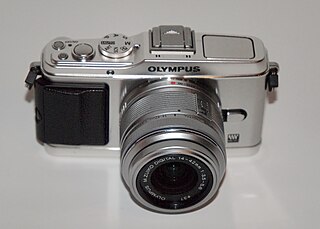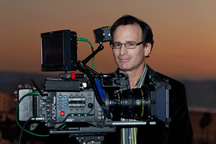
A single-lens reflex camera (SLR) is a camera that typically uses a mirror and prism system that permits the photographer to view through the lens and see exactly what will be captured. With twin lens reflex and rangefinder cameras, the viewed image could be significantly different from the final image. When the shutter button is pressed on most SLRs, the mirror flips out of the light path, allowing light to pass through to the light receptor and the image to be captured.

The EF lens mount is the standard lens mount on the Canon EOS family of SLR film and digital cameras. EF stands for "Electro-Focus": automatic focusing on EF lenses is handled by a dedicated electric motor built into the lens. Mechanically, it is a bayonet-style mount, and all communication between camera and lens takes place through electrical contacts; there are no mechanical levers or plungers. The mount was first introduced in 1987.

The Canon FD lens mount is a physical standard for connecting a photographic lens to a 35mm single-lens reflex camera body. The standard was developed by Canon of Japan and was introduced in March 1971 with the Canon F-1 camera. It served as the Canon SLR interchangeable lens mounting system until the 1987 introduction of the Canon EOS series cameras, which use the newer EF lens mount. The FD mount lingered through the release of the 1990 Canon T60, the last camera introduced in the FD system, and the end of the Canon New F-1 product cycle in 1992.
Cinema Products Corporation was an American manufacturer of motion picture camera equipment.

For an interchangeable lens camera, the flange focal distance (FFD) of a lens mount system is the distance from the mounting flange to the film plane. This value is different for different camera systems. The range of this distance, which will render an image clearly in focus within all focal lengths, is usually measured in hundredths of millimeters and is known as the depth of focus.

The M42 lens mount is a screw thread mounting standard for attaching lenses to 35 mm cameras, primarily single-lens reflex models. It is more accurately known as the M42 × 1 mm standard, which means that it is a metric screw thread of 42 mm diameter and 1 mm thread pitch. It was first used in Zeiss' Contax S of 1949; this East German branch of Zeiss also sold cameras under the Pentacon name; after merger with other East German photographic manufacturers, the name Praktica was used. M42 thread mount cameras first became well known under the Praktica brand, and thus the M42 mount is known as the Praktica thread mount. Since there were no proprietary elements to the M42 mount, many other manufacturers used it; this has led to it being called the Universal thread mount or Universal screw mount by many. The M42 mount was popularized in the United States by Pentax; thus, it is also known as the Pentax thread mount, despite the fact that Pentax did not originate it.
Arri bayonet is a lens mount developed by Arri for use with both 16 mm and 35 mm movie camera lenses. Lenses of this type are distinguished by "outer wings" which both control aperture and bayonet alignment, and are placed in the mount while two pressure tabs are simultaneously depressed at the side of the lens mount on the camera. These tabs provide a relatively strong locking mechanism which allows for higher quality lens seating than offered by the Arri standard mount. Debuting in 1965 with the 16BL, the Arri bayonet mount superseded the Arri standard mount, but cameras with the bayonet mount were also able to accommodate Arri standard lenses due to both mounts having the same flange focal distance and diameter. However, cameras with Arri standard mounts were unable to fit lenses with Arri bayonet mounts, due to the locking mechanism. The bayonet mount began to be superseded around 1980 by the Arri PL mount, which has since become an overwhelmingly predominant mount for most modern cameras, along with Panavision and their PV mount.
Arri PL is a lens mount developed by Arri for use with both 16 mm and 35 mm movie cameras. The PL stands for "positive lock". It is the successor mount to the Arri bayonet; unlike the bayonet mount, however, it is incompatible with older Arri-mount lenses, due to the larger diameter.
BNCR is a lens mount developed by Mitchell for use with their REFLEX 35 mm movie cameras. It was an update of the BNC mount done to accommodate the reflex viewer in the later cameras. BNC mount lenses cannot be used in reflex Mitchell cameras as their shorter back-focus will hit and damage the reflex viewer, which, in various versions, was a pellicle mirror or a rotating mirror. The abbreviation stands for "Blimped Newsreel Camera Reflex", which meant that it is a 35 mm camera originally intended for news reporting but included a blimp housing for sound stage shooting plus a reflex viewer to allow the camera operator to view the action through the lens while filming. The reflex option was only added in 1967, while the blimp option was available at the camera's introduction in 1934, but only a few BNC examples were made before the onset of WW-II, during which manufacture of "production" cameras was suspended.
Arri standard is a lens mount developed by Arri for use with both 16 mm and 35 mm movie cameras. Lenses are distinguished by a tab inside an outer ring. Because of the weak seating strength and ability of the aluminum mount to gradually become poorly seated, the stainless steel Arri bayonet mount superseded the Arri standard mount in 1965, debuting on the 16BL. However, cameras with the bayonet mount are also able to accommodate Arri standard lenses due to both mounts having the same flange focal distance and diameter. Unfortunately, cameras with Arri standard mounts are unable to fit lenses with Arri bayonet mounts, due to the bayonet mount's locking mechanism.

The Arriflex 435 is a movie camera product line created by Arri in 1995 to replace the Arriflex 35III line. The number reflects its position as a successor camera to the Arri III and the fact that it is designed for 35 mm film. The 435 cameras are specifically designed as MOS cameras, which means that they are conventionally considered to be too loud to record usable location sound. However, this also frees the camera up to be optimized for non-sync sound uses, particularly any filming which either doesn't require sound or shooting at non-sync speed, shooting in reverse, or ramping between different speeds. As such, its potential applications are widespread, and thus it is regularly used on music videos, commercials, second unit work on features, special effects work, and motion control, among other usage. It is currently considered to be the most popular 35 mm movie camera in usage, due to its wide range of production adoption, intuitive design, high reliability, and retail availability. Rival Panavision even owns more 435s for rental than Arri's own hire houses; Panavisions, however, can be converted to Pan-Arri 435s where they are modified to accept Panavision lenses and accessories. In recognition of the achievements of the 435 system, AMPAS awarded Arri a Scientific and Engineering Academy Award in 1999.

Anamorphic format is the cinematography technique of shooting a widescreen picture on standard 35mm film or other visual recording media with a non-widescreen native aspect ratio. It also refers to the projection format in which a distorted image is "stretched" by an anamorphic projection lens to recreate the original aspect ratio on the viewing screen. The word anamorphic and its derivatives stem from the Greek words meaning "formed again". As a camera format, anamorphic format is losing popularity in comparison to "flat" formats such as Super 35 mm film shot using spherical lenses; however, because most film movie projectors use anamorphic projection format, spherical format negatives are commonly converted into anamorphic prints for projection.
Panavision has been a manufacturer of cameras for the motion picture industry since the 1950s, beginning with anamorphic widescreen lenses. The lightweight Panaflex is credited with revolutionizing filmmaking. Other influential cameras include the Millennium XL and the digital video Genesis.

The Micro Four Thirds system is a standard released by Olympus and Panasonic in 2008, for the design and development of mirrorless interchangeable lens digital cameras, camcorders and lenses. Camera bodies are available from Blackmagic, DJI, JVC, Kodak, Olympus, Panasonic, Sharp Corporation, and Xiaomi. MFT lenses are produced by Cosina Voigtländer, DJI, Kowa, Kodak, Mitakon, Olympus, Panasonic, Samyang, Sharp Corporation, Sigma, SLR Magic, Tamron, Tokina, Veydra, and Xiaomi, amongst others.

The Arri Alexa is a digital motion picture camera system made by Arri first introduced in April 2010. The camera was Arri's first major transition into digital cinematography after smaller previous efforts such as the Arriflex D-20 and D-21.

The Olympus PEN E-P3 announced on 30 June 2011 is Olympus Corporation's seventh camera that adheres to the Micro Four Thirds (MFT) system design standard. The E-P3 succeeds the Olympus PEN E-P2, and was announced in concert with two other models, the Olympus PEN E-PL3, and the Olympus PEN E-PM1.

The Narciss is an all-metal 16 mm subminiature single lens reflex camera made by Russian optic firm Krasnogorsky Mekhanichesky Zavod (KMZ) Narciss between 1961 and 1965. It is the first subminiature SLR. It took 25 14×21 mm frames using unperforated specially spooled 16 mm film in a Narciss cassette. Compact design with interchangeable lenses and interchangeable pentaprism finders. The Narciss camera was initially designed for medical use, it included a Narciss with ordinary pentaprism finder and a second magnifier pentaprism finder for medical use; there was also a microscope adapter













